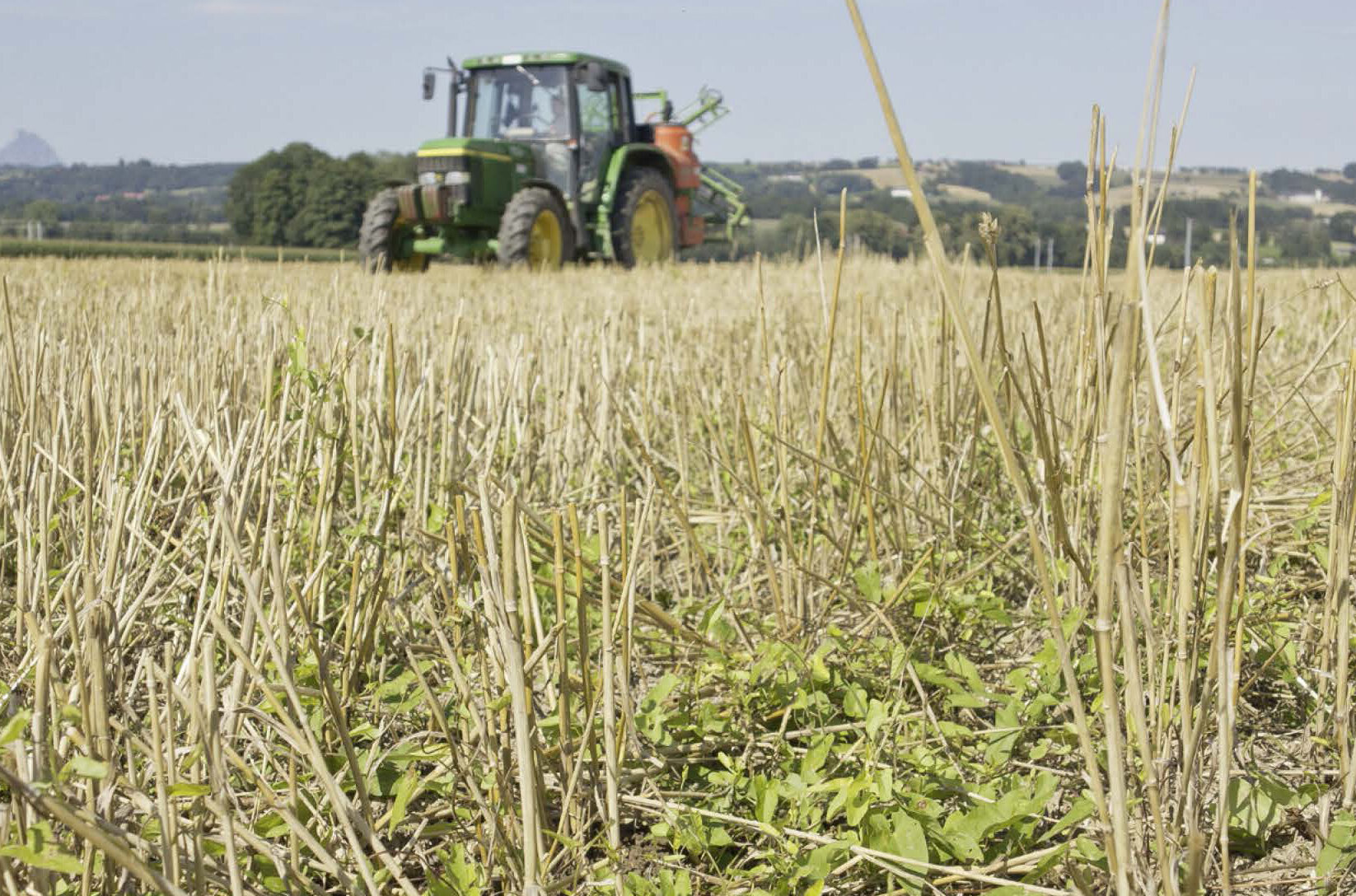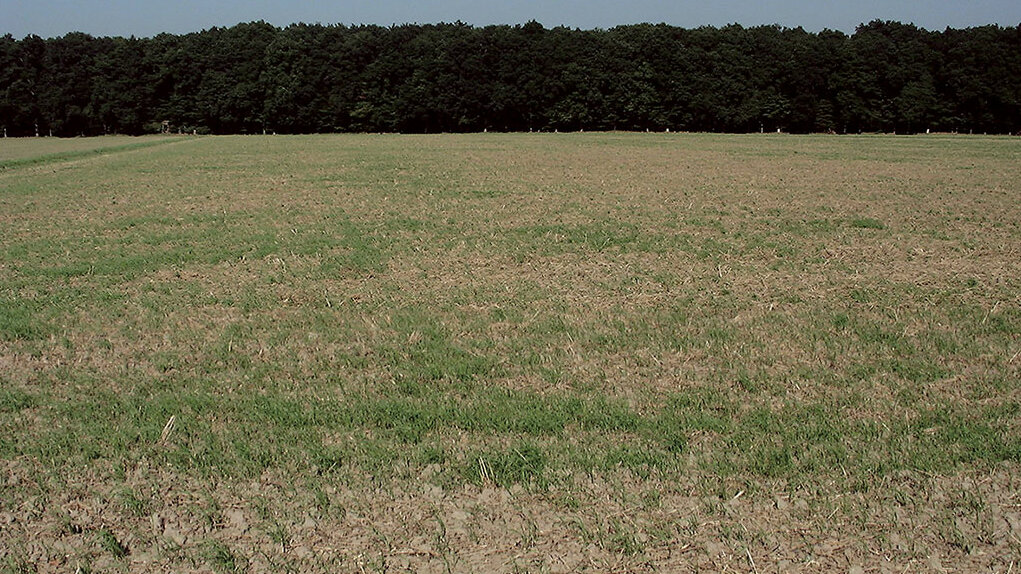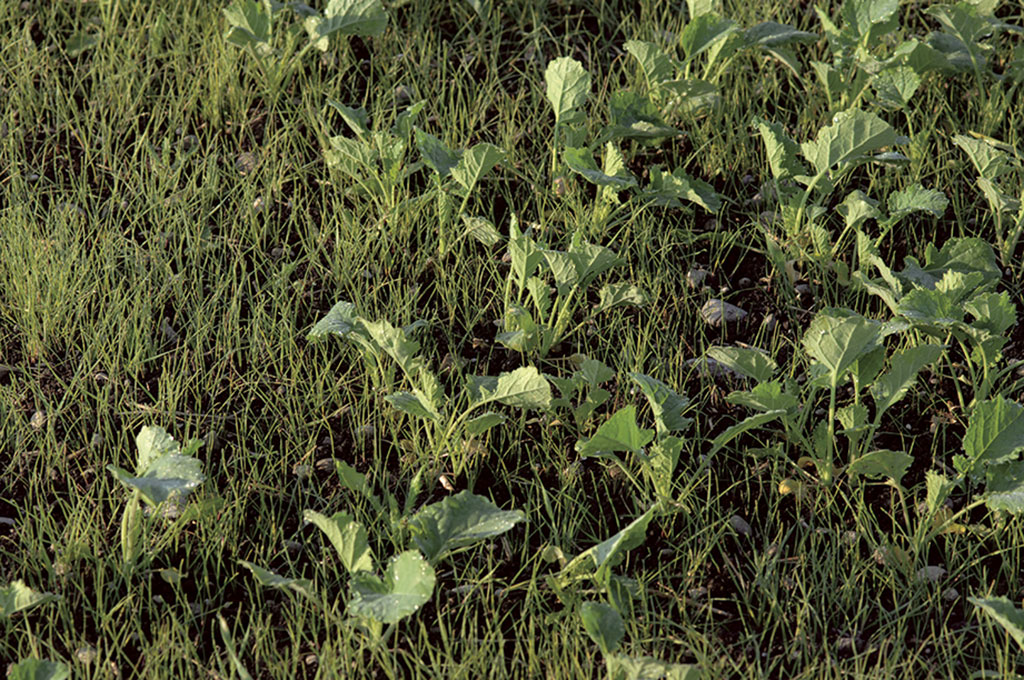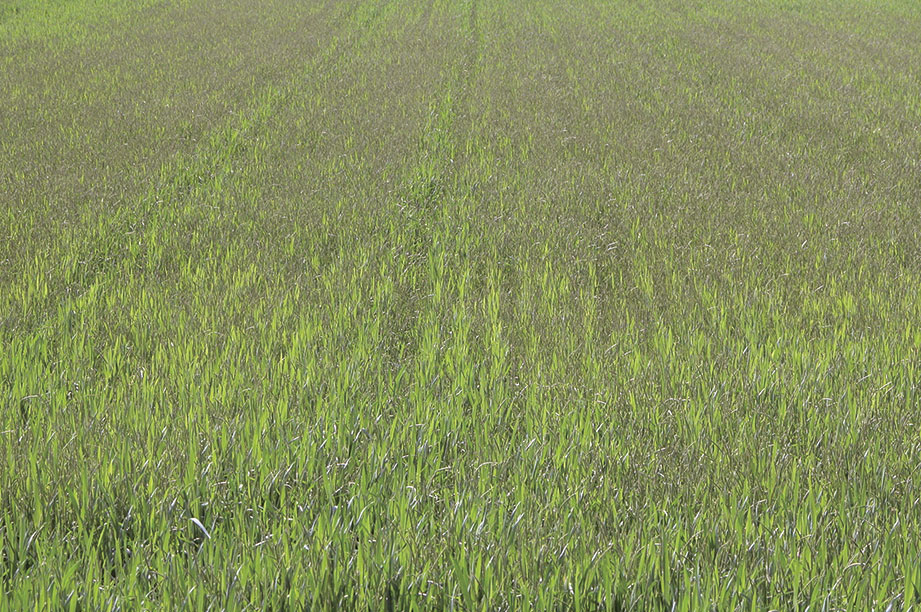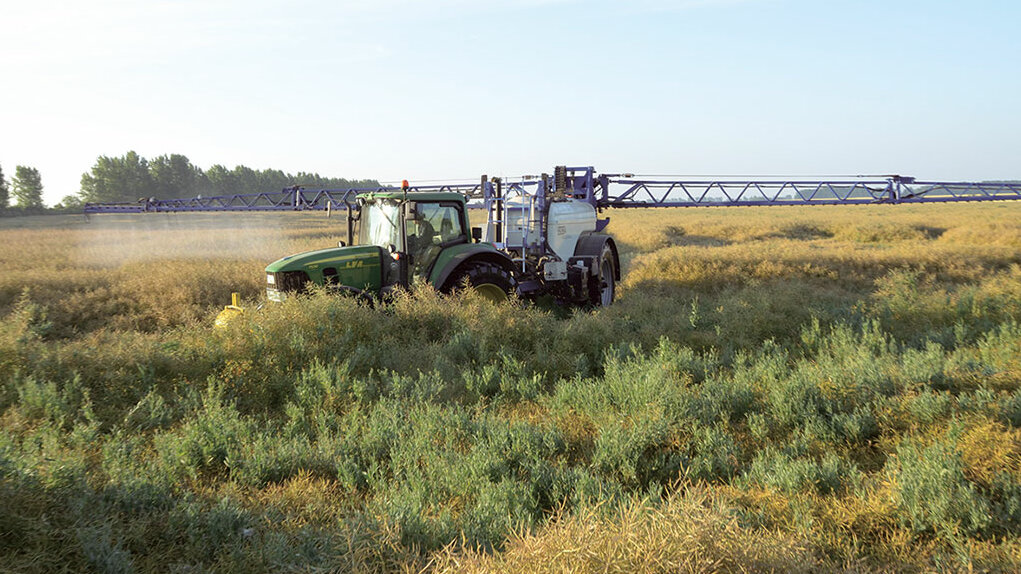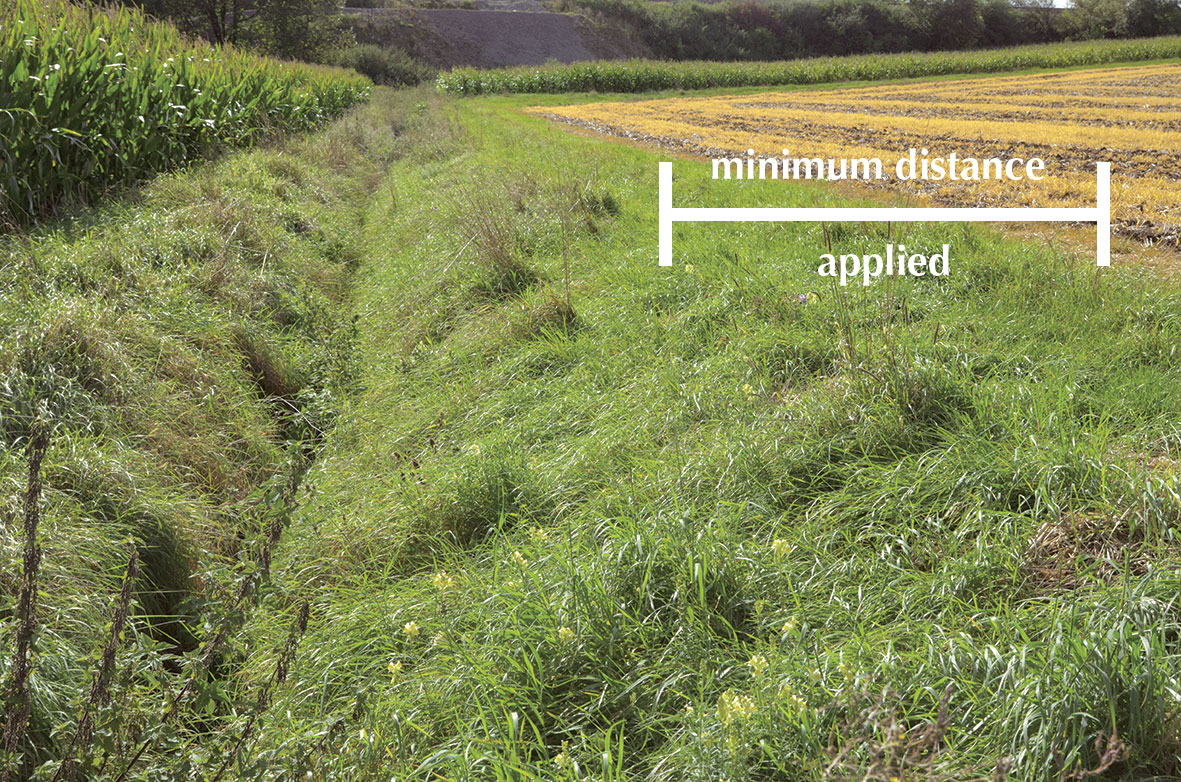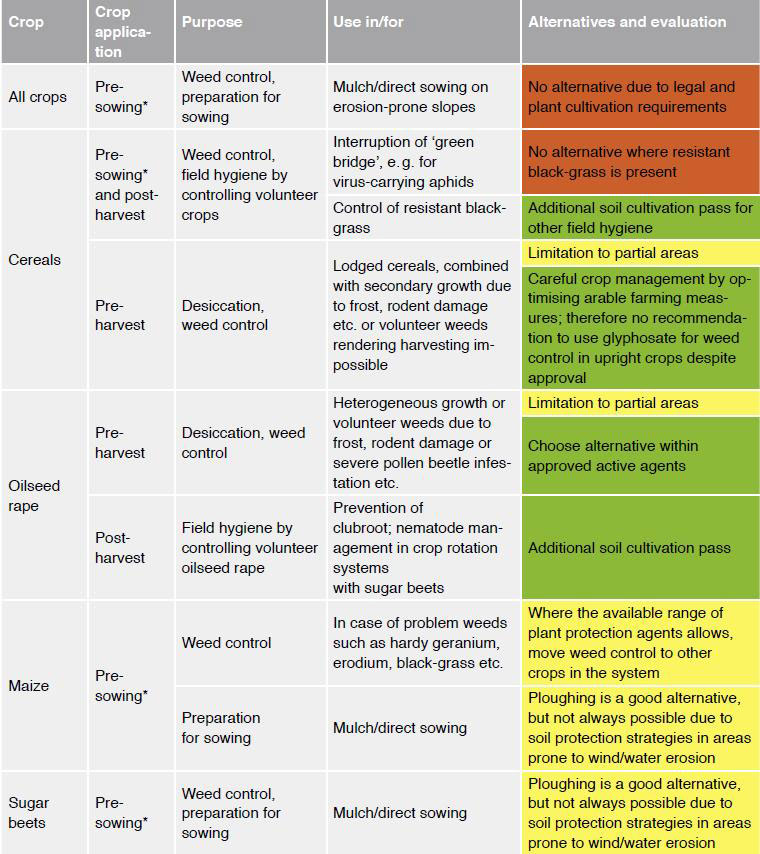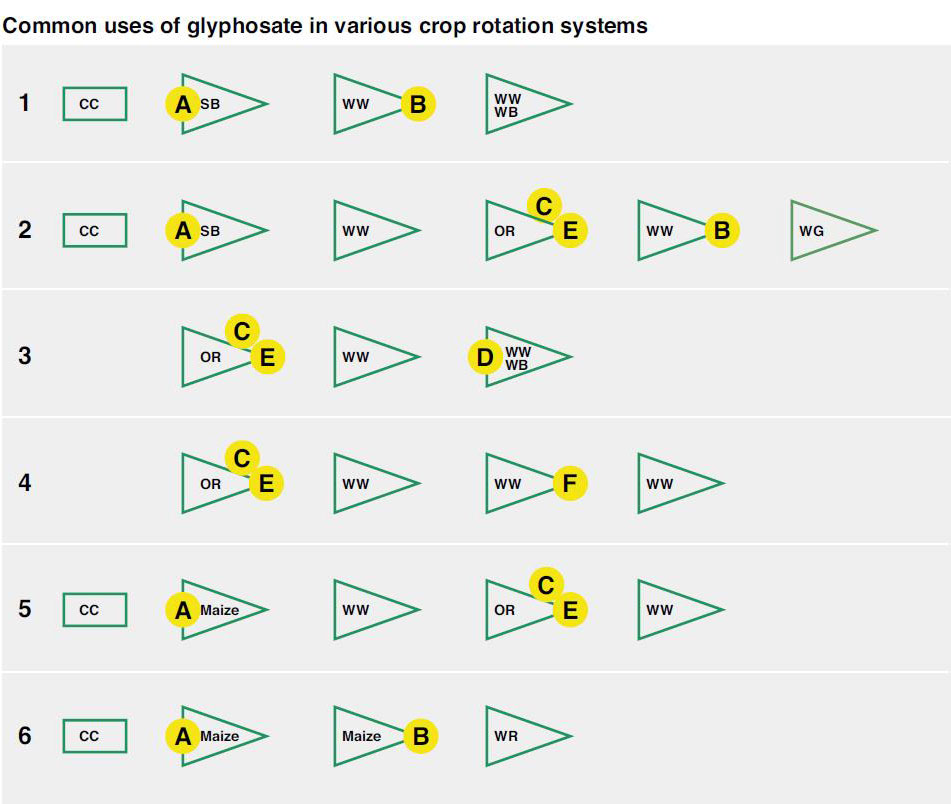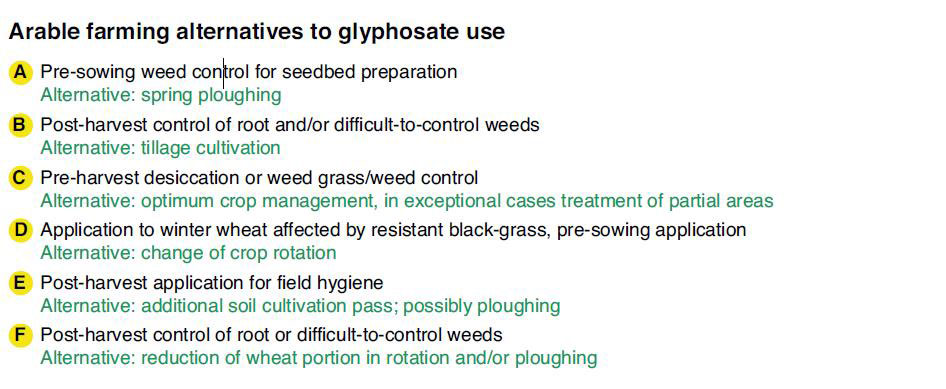Glyphosate
DLG expert knowledge 391
1. Preface
Glyphosate was first launched on the German market in the mid-1970s as a component of the plant protection product Roundup. Currently 69 plant protection products containing glyphosate are approved for use in arable farming. Their applications range from treating individual plants to combating volunteer cereals, controlling weeds and weed grasses and finally to desiccating lodging cereals and oilseed rape.
Outside these agricultural applications, glyphosate is also widely used in domestic and kitchen gardens, in treating non-agricultural land and – outside Germany – in genetically engineered cultures.
Due to this broad range of applications, glyphosate has become the most widely used herbicide worldwide.
EU authorities are currently examining glyphosate as part of their regular renewal assessment procedure, and this reassessment will form the basis for its ongoing approval. The renewal assessment process must be completed by 31 December 2015.
There is, however, decreasing acceptance of glyphosate by the public. There are a range of reasons for this development, although criticism often focuses on the overall quantities of glyphosate being applied. While the benefits of glyphosate for crop production are undisputed, its responsible use is essential if the increasing public debate about glyphosate is to be defused, and in some areas its application rate could be reduced.
This information sheet aims to outline the relevance and – to some extent – the indispensability of glyphosate and to support farmers in handling and using this substance. It also briefly describes and evaluates the main fields of application in agriculture and identifies possible alternatives to glyphosate use in arable farming.
This publication is not intended to examine the effects of glyphosate on the health of humans, animals and ecosystems; for relevant information please refer to the work of the various authorities involved in approving this substance, including the Federal Environment Agency (www.uba.de) and the Federal Institute for Risk Assessment (www.bfr.bund.de), and the German registration authority itself, the Federal Office of Consumer Protection and Food Safety (www.bvl.bund.de).
The Authors
2. Main applications in arable farming
Plant protection products containing glyphosate are widely used in arable farming in Germany. A study by Göttingen University, Germany, has identified a certain emphasis and a few focal points as far as the frequency of application is concerned (M. Dickeduisberg et al., 2012). According to this study, glyphosate is used on 39?% of arable land. Approx. 80% of winter oilseed rape fields and approx. 70% of grain legume fields are treated with glyphosate. As winter oilseed rape, winter barley and winter wheat are the most commonly grown crops, they also represent the largest areas treated.
There are three main approaches to applying glyphosate:
- Pre-sowing application (use just before sowing or pre-emergent use after sowing)
- Pre-harvest application (use on crops just before harvesting)
- Post-harvest application (use after harvesting)
2.1 Weed control
Post-harvest weed control
The post-harvest application of glyphosate is mainly aimed at controlling weeds that are difficult to manage, e.g. couch grass, brome and creeping thistle. Glyphosate applied at that time of the season can be used to substitute a stubble cultivation pass for managing these weeds and volunteer cereals. While glyphosate is mainly applied post-harvest in the context of reduced soil cultivation, this approach is also being used more and more on tilled fields where winter oilseed rape is rotated with legumes.
Pre-sowing weed control
Pre-sowing applications of glyphosate for weed control are mainly found in mulch/direct sowing of sugar beets or maize after catch crops.
This use is aimed at creating an environment of low competition for the emerging crop. It also includes early pre-emergent application after sowing.
2.2 Field hygiene
As a measure for field hygiene, glyphosate is applied to break the so-called ‘green bridge’ of weeds, weed grasses and volunteer cereals, which allows pests such as virus-infected aphids to migrate from recently harvested to newly sown fields, where they can then develop and colonise successive or adjacent crops.
Post-harvest applications of glyphosate to control volunteer oilseed rape acting as a ‘green bridge’ are important in both oilseed rape and combined oilseed rape/sugar beet crop rotation systems.
Glyphosate is often applied to eliminate volunteer oilseed rape before the two-leaf stage in order to manage the potential spread of clubroot, which cannot be treated directly. The presence of volunteer oilseed rape also promotes the development and reproduction of nematodes and makes it difficult to grow oilseed rape and sugar beets in crop rotation. Volunteer oilseed rape therefore needs to be treated at a time that ensures that nematodes are encouraged to hatch, yet they are not given the chance to develop beyond the first generation. A temperature sum model can be used to determine the best time for applying glyphosate to control volunteer oilseed rape.
2.3 Resistance management
Weed grass resistance, predominantly of black-grass and silky-bent grass, is becoming more and more of a problem in almost all arable farming regions in Germany, Glyphosate therefore plays an important role as a farm input for resistance management in cereal-growing regions, as it is virtually irreplaceable in treating resistant weed grasses. Glyphosate is applied post-harvest to control emergent weed grasses and supplemented by a combination of autumn and spring treatments with special weed grass herbicides.
Figure 3: Resistant black-grass is difficult to manage (© landpixel)
2.4 Pre-harvest desiccation and weed control
As a rule:
Pre-harvest applications of glyphosate are exceptional and must not be used as a tool for controlling and planning the time of harvest!
Any pre-harvest application may only be considered as a one-time and exceptional solution to avert the risk of harvest not being possible at all or subsequential damage.
Oilseed rape
Desiccating oilseed rape can only be justified where crops are maturing very unevenly due to secondary growth caused by frost, rodent damage or pollen beetle infestations, among others (significant pre-harvest secondary flowering), or where harvesting a field would otherwise be impossible due to volunteer weeds. It is often sufficient to treat only problematic sections of a field.
Cereals
The use of glyphosate for desiccating cereals is only justified in localised patches where crops have lodged and the pressure of volunteer weeds render harvesting impossible. The same applies for secondary growth in patches with lodged or standing crops. Again, glyphosate treatment is allowed only for the reason of averting the risk of not being able to harvest at all.
In some cases, the pre-harvest application of glyphosate on barley and rye has caused large crop losses. Where this total herbicide is used, the harvest date can be essentially determined by the day, but if the harvest is delayed due to changes in weather, substantial losses have at times been observed in practice due to snapped ears or collapsed crops.
It is imperative to take the following into account:
- Compliance with the appropriate time of application (from BBCH 89 = full maturity)
- Compliance with pre-harvest intervals (7–14 days, depending on product)
Compliance with maximum permitted residue rates can only be ensured if the pre-harvest interval is adhered to. It is therefore essential to check closely whether the weather forecast allows planning for the pre-harvest application of glyphosate before the product is applied.
2.5 Field recultivation
Agricultural policy or business requirements sometimes make it necessary to recultivate fallow land, which often carries highly persistent, deeply rooting weeds. Glyphosate is an economically sensible farm input that is able to control these weeds while preserving the soil.
3. Glyphosate and water
Due to the intrinsic properties of glyphosate, there is a minor risk that this active agent may leach into ground water. This also applies to its metabolite AMPA, a degradation product of glyphosate. AMPA is not classified as relevant, as it does not act as a plant protection agent and has no other toxicological or ecotoxicological characteristics that would present a ground water risk.
The metabolite AMPA can also derive from other industrial applications, e.g. detergents.
Both glyphosate and AMPA are found only rarely in ground water due to the degradation and leaching behaviour of these two substances. However, this is not the case where these products enter surface waters, which mainly happens through surface run-off and drainage.
The portion of such discharges into surface waters that is due to agricultural applications should not be underestimated, and the use of most plant protection products containing glyphosate is therefore subject to regulations intended to protect surface waters. These include two regulations on applying such products on sloped fields; these regulations differ in the width of the vegetated margin that is required (NG 402 = 10 m; NG 412 = 5 m) (German legal regulation).
The regulations governing the use of glyphosate read as follows:
‘A margin with complete vegetation cover must be provided between treated areas with a slope exceeding 2% and any surface waters, except where such waters only carry water occasionally, but including any bodies of water that carry water periodically. The protective purpose of this margin may not be impaired by the use of implements or tools. The margin must have a minimum width of 10 m (NG 402) (NG 412 = 5 m) (German legal regulation).
The margin is not required where:
- there are adequate catchment systems for draining water and soil and these catchment systems do not lead to surface waters and are not connected to the sewage system;
- the product is applied with mulch or direct sowing.’
4. Effectively combining measures in arable farming
The effects of certain glyphosate applications can also be achieved by other measures in arable farming. Some examples are discussed below:
Many glyphosate treatments, especially on stubble, are applied as a substitute for soil cultivation. However, a substantial decrease in glyphosate application rates, particularly in mulch seeding of oilseed rape, can be achieved by effectively combining glyphosate with other pre-emergence herbicides. The use of active substances can, above all, be significantly reduced by reintroducing soil cultivation passes, as this allows the secondary effects of stubble cultivation to be utilised to a much greater degree. These effects include the breaking of capillary action, thus, water evaporation, the incorporation of straw and the control of slugs and rodents, among others, and for the purposes of arable farming they are more valuable than the mere cost benefits obtained from using glyphosate.
Good arable farming practice is also regaining more importance in weed control; stubble and soil cultivation need to be intensified.
Couch grass – a special case
Measures for controlling couch grass should be carried out in between crops. This requires a sufficient time frame between the harvest of the previous crop and the sowing of the subsequent crop. This is where working without glyphosate would likely cause the greatest problems; and there are hardly any suitable alternatives for controlling couch grass reliably in the long term.
Post-harvest application and stubble cultivation
Volunteer oilseed rape and cereals can be caused to emerge in several waves between harvest and sowing. Oilseed rape germinates as soon as it has sufficient light. Shallow soil cultivation is generally more effective in controlling volunteer oilseed rape in the long term than applying herbicides merely killing off the first wave of emergence. Eventually, remaining seed will start to germinate as soon as they again receive sufficient light after treatment. Changing temperatures and moisture levels between daytime and night time are then usually sufficient to cause the seeds to swell and germinate.
For stubble management, farmers can opt for a combination of mechanical and chemical treatments.
With volunteer cereals, merely killing off the first wave of emergence is not enough to cause remaining volunteer grains to emerge well, especially during dry periods. Stubble may need to be treated repeatedly in cereal-cereal or cereal-oilseed rape rotation systems in order to achieve optimum success in controlling volunteer crops and weed grasses such as black-grass, bromes and ryegrasses.
Care should be taken in any event that volunteer plants are not permitted to grow too tall. The smaller the plants and the lower the risk of them becoming vital again, the greater the success in controlling volunteer crops.
Mice and slugs cannot be starved by applying glyphosate. To control mice, soil must be cultivated sufficiently deeply to reach and destroy burrows. This may be repeated after 10–14 days to prevent rapid recolonisation.
Shallow soil cultivation suffices to control slugs; this is ideally done before a dry period. Soil cultivation deprives slugs of shelter, and a subsequent dry period causes high mortality among populations.
The following table summarises the most common glyphosate applications and evaluates their alternatives.
* Pre-sowing applications may include pre-emergent application after sowing.
Red: no alternative possible
Green: recommended alternative
Yellow: individual decision
The diagram shows certain times when glyphosate is commonly applied and possible alternatives for six different crop rotations.
The diagram illustrates, among others, that glyphosate has become a fixed, indispensable input in modern arable farming. That is why it is even more important to use this substance responsibly if we are to ensure that we will be able to rely on its effects and full range of applications in the long term.
5. Outlook
Good arable farming practice will not rely solely on chemicals, but will combine all available measures to maintain the full productive capacity of the arable land in the long term.
There is potential for optimising the use of glyphosate, with crop rotation and soil cultivation representing the main areas where adjustments can be made. However, financial arguments are often presented against the use of either of these options, although these arguments are not always justified.
Utilising the full benefits of crop rotation effects, choice of variety, sowing times, mechanical soil cultivation and the targeted use of plant protection products can often yield better results than the ongoing use of glyphosate. This places considerable demands on farm managers, as they only have limited scope for corrections. The aim is to eliminate competing weeds in a timely manner and to combine chemical with mechanical measures (e.?g. breaking of capillary action, slug control).
The decision to do without certain glyphosate applications must be taken based on the specific environmental conditions given. Ultimately, applying a combination of various measures offers greater safety in arable farming while reducing the use of plant protection products.
6. Bibliography
M. Dickeduisberg, H.-H. Steinmann und L. Theuvsen (2012): Erhebungen zum Einsatz von Glyphosat im deutschen Ackerbau; Julius-Kühn-Archiv 434, pp. 459–462
H.-H. Steinmann, M. Dickeduisberg, L. Theuvsen (2012): 5.000 t – wofür eigentlich? DLG-Mitteilungen 2/2012, pp. 18–19
Always comply with approval requirements when applying plant protection products containing glyphosate!
© Reproduction and transfer of individual sections of text, drawings or photos (including for the purpose of teaching) and the provision of the Expert Knowledge Series 450 in whole or in part for viewing or downloading by third parties only with the prior approval of DLG e.V., Marketing Service Department, Eschborner Landstraße 122, 60489 Frankfurt am Main, Germany, tel. +49 69 24788-209, M.Biallowons@DLG.org

